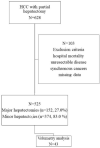Reappraisal of the Role of Alkaline Phosphatase in Hepatocellular Carcinoma
- PMID: 35455635
- PMCID: PMC9030712
- DOI: 10.3390/jpm12040518
Reappraisal of the Role of Alkaline Phosphatase in Hepatocellular Carcinoma
Abstract
Background: Alkaline phosphatase (ALP) is a marker of liver function and is associated with biliary tract disease. It was reported as a prognostic factor for hepatocellular carcinoma (HCC). The genetic expression in tumor-tissue microarrays and the perioperative serologic changes in ALP have never been studied for their correlation with HCC prognosis. Methods: The genetic expression of ALP isoforms (placental (ALPP), intestinal (ALPI) and bone/kidney/liver (ALPL)) was analyzed in tumor and non-cancerous areas in 38 patients with HCC after partial hepatectomy. The perioperative change in ALP was further analyzed in a cohort containing 525 patients with HCC to correlate it with oncologic outcomes. A total of 43 HCC patients were enrolled for a volumetry study after major and minor hepatectomy. Results: The genetic expression of the bone/kidney/liver isoform was specifically and significantly higher in non-cancerous areas than in tumors. Patients with HCC with a higher ALP (>81 U/dL) had significantly more major hepatectomies, vascular invasion, and recurrence. Cox regression analysis showed that gender, major hepatectomies, the presence of satellite lesions, higher grades (III or IV) and perioperative changes in liver function tests were independent prognostic factors for recurrence-free survival, and a postoperative increase in the ALP ratio at postoperative day (POD) 7 vs. POD 0 > 1.46 should be emphasized. A liver regeneration rate more than 1.8 and correlation analysis revealed that the ALP level at POD 7 and 30 was significantly higher and correlated with remnant liver growth. Conclusions: This study demonstrated that the perioperative ALP change was an independent prognostic factor for HCC after partial hepatectomies, and the elevation of ALP represented a functional biomarker for the liver but not an HCC biomarker. The higher regeneration capacity was possibly associated with the elevation of ALP after operation.
Keywords: alkaline phosphatase; hepatocellular carcinoma; liver regeneration.
Conflict of interest statement
The authors declare no conflict of interest.
Figures





References
-
- Leung T.W., Tang A.M., Zee B., Lau W.Y., Lai P.B., Leung K.L., Lau J.T., Yu S.C., Johnson P.J. Construction of the Chinese University Prognostic Index for hepatocellular carcinoma and comparison with the TNM staging system, the Okuda staging system, and the Cancer of the Liver Italian Program staging system: A study based on 926 patients. Cancer. 2002;94:1760–1769. doi: 10.1002/cncr.10384. - DOI - PubMed
LinkOut - more resources
Full Text Sources
Miscellaneous

